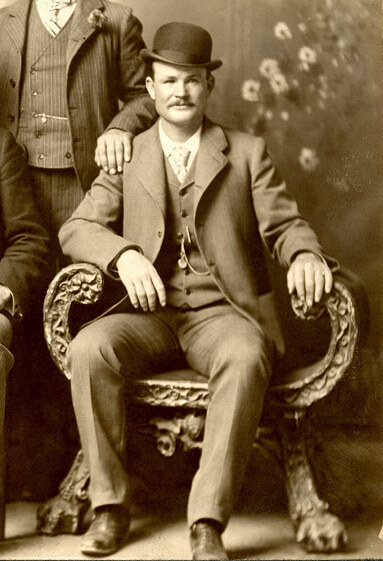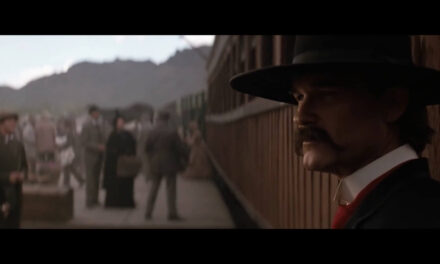Very few periods in American History, or any history for that matter, capture the imagination through tv shows, movies and books quite like the American Old West. Many people hold great admiration for the famous lawman that bravely sought to bring law and order to that untamed frontier, while others are equally in awe of the outlaws which made their job so difficult.
But considering the nature of the lawless old west, one has to ask the question: what was the fine line between lawman and outlaw? What was it that drove men to either side? The answer to that question is more complicated than you might think.
Much of the Old West sprang from the aftermath of the Civil War. All that many men knew was serving as a soldier for one side or the other. When the war ended, they were jobless and without skills, except of course the skill of handling a gun. The American frontier was wide open, and many men would head west in search of fortune, a job, or to simply make trouble.

"Civil War, Kelham Hall. Glass Plates" by Ikonta Bloke is marked with Public Domain Mark 1.0.
Many areas of the old west lacked laws, courts, or even well-established governments. This created a breeding ground for outlaws. Therefore, by necessity, it brought forth a breeding ground for lawmen as well. Life was tough in frontier towns, and the kind of man that would become an outlaw shared many of the same qualities that the lawmen would also need, if they were to have a meaningful effect. In fact, some of the most well know figures from this era could be described as both.
The Outlaw
For many, when they think of the old west, it is the outlaw that comes to mind first. It’s hard to put a finger on exactly what is so attractive about these outlaws, but we likely look at them in the same way as pirates like Blackbeard or conquerors like Genghis Khan. When legends abound, herein lies romance. Some of the most notorious outlaws have even become household names, such as Jesse James, Billy the Kid, or Butch Cassidy.

Butch Cassidy, 1901
It might be surprising to learn that for many of these men, life could have turned out very different. Butch Cassidy was not a murderer. In fact, it is thought that he never killed anyone. In fact, there is evidence that he refused to kill when other outlaws surely would. He was polite, and even his wanted poster described him as essentially a nice guy. But he was an outlaw, through and through.
Even his partner in crime, the Sundance Kid, is believed to have never killed any men during his lifetime. They did, however, commit a rather extensive list of bank and train robberies.
Billy the Kid was intelligent, likeable, and to his credit tried to start his life out right as a sort of unofficial “lawman” as part of the Regulators. He even attempted to arrest Sheriff William Brady after he gunned down rancher John Tunstall. But the cards were stacked against Billy, and he never really had a chance in the unforgiving old west. Although he was loved by many, popular with the ladies, and deadly with a gun, he eventually met the same fate as did most outlaws: shot dead far too young in life.

Billy the Kid
And then there were the outlaws of the worst kind.

Jim Miller c. 1886
Take Jim Miller, who ironically was once a Texas Ranger. He killed his grandparents at the ripe old age of 8. He became a psychopathic hitman, killing somewhere between 20 and 50 men before he himself was hanged in 1908.
Or rather lynched..
Reports say that he himself stepped off the block voluntarily, shouting “Let ‘er rip!”
And of course, who hasn’t heard of John Wesley Hardin. Hardin killed as many as 21 men in duels, ambushes, and cold blooded murders. History often portrays him as the man “so mean he killed a man for snoring”. While in essence true, the fact is he didn’t actually mean to kill the snoring man. He fired two shots through a wall in an attempt to wake him. However, of course, the end result is exactly the same.

John Wesley Hardin c. Unknown
Lawman
The Lawmen of the old west were every bit as legendary as the outlaws. Just as much, if not more fame surrounds names like Wyatt Earp and Wild Bill Hickok. And in many ways, these lawmen were not so different than the outlaws they confronted.
The names Wyatt Earp and Doc Holiday often accompany each other and continue to live on in the imagination of many for their participation in the battle at the OK Corral.

Doc Holiday c. 1882
While famous for acting as lawmen, each man was also known for behavior that would be more fitting for an outlaw. Holiday was a gambler and an alcoholic. And he was a fierce gun fighter. Although he only has 2 confirmed kills, no one knows the true number. It sometimes becomes difficult to separate the facts from the legend. But he always seemed to be on the side of the law when it mattered the most.
Earp also had issues with the law in his younger years, even once being wanted for horse thievery. Earp wasn’t known for being particularly fast with a gun, but he had a fearless attitude and possessed a great desire to right much of the wrongs that he witnessed. He developed a reputation that always preceded him wherever he went.

Wyatt Earp c. 1887
After the murder of his brother Morgan, Earp and Holiday formed a posse and began a ride of revenge. By some accounts, they killed 6 or more men in their war on the Clanton faction. This posse was never quite official, and a warrant for Earp and Holiday was issued but never served.

Wild Bill Hickok c. 1860's
Perhaps the most feared lawman was Wild Bill Hickok. He was given the name “Wild Bill” for his daring service as a scout, sharpshooter, and spy for the Union Army in the Civil War. Hickok always seemed to walk a fine line between lawman and outlaw.
Once he killed a skilled gunfighter named David Tutt in a shootout over a pocket watch that he had taken from Bill in a poker game. He was arrested for murder and stood trial, but he was acquitted.
Hickok loved to dress in the latest, daring fashion. He often wore brightly colored shirts and sported long hair and a healthy mustache. This was, to some, in contrast to his rough and wild temperament. Although he had a temper, he could also be kind and courteous to strangers.


Wild Bill c. 1873
In 1869, Hickok became sheriff of Hays City, Kansas. He killed several men during shootouts during his tenure. In 1871 he assumed the office of marshal of the gritty cow town of Abilene, Kansas. As was his habit, he killed more men in gunfights there as well. It was here that he accidentally shot and killed his deputy, which led to him being dismissed from his position.
In his later years, with a worsening drinking problem and failing eyesight, he became a peace officer in deadwood South Dakota. During a poker game, Hickok was sitting with his back to the door, which is something he would never usually do. He was shot in the back of the head by Jack McCall, who would later hang for the crime.
Most historians agree that Hickok killed at least 6 to 8 men in various gunfights, most of which were acting as a lawman. But this number is by no means certain, and many argue the number was quite higher, and not all were defensible.
Lawman or Outlaw?
Because of the lawless nature of the old west, the line between lawman and outlaw could be razor thin. When there was no real law to depend upon, some men would do what they though was needed to keep the peace, legal or not.

Doc Holiday, Tombstone, Walt Disney Pictures
Self-defense was a broad term but made for the most common rationale in many killings of the day. If there were witnesses, and it was reasonable to assume that the other fellow started it, it was probably legal.
But one thing separated lawmen from outlaws, and that was robbery.
Jesse James may have considered himself the robin hood of his time, but there was no doubt he was a criminal and murderer. Whether it was a bank, stagecoach, or train, outlaws always made their money by stealing.

Jesse James c. 1882
Those that didn’t were probably murderers for hire.
Either way, it was activities like these that distinguished the outlaw from the lawman. Fortunately, the toughest outlaw was equally matched with lawman of the day to strike a balance that allowed the eventual taming of the western frontier.

Wyatt Earp, Tombstone, Walt Disney Pictures
If you enjoyed this content, please share! Leave a comment, we would love to hear what you have to say!








